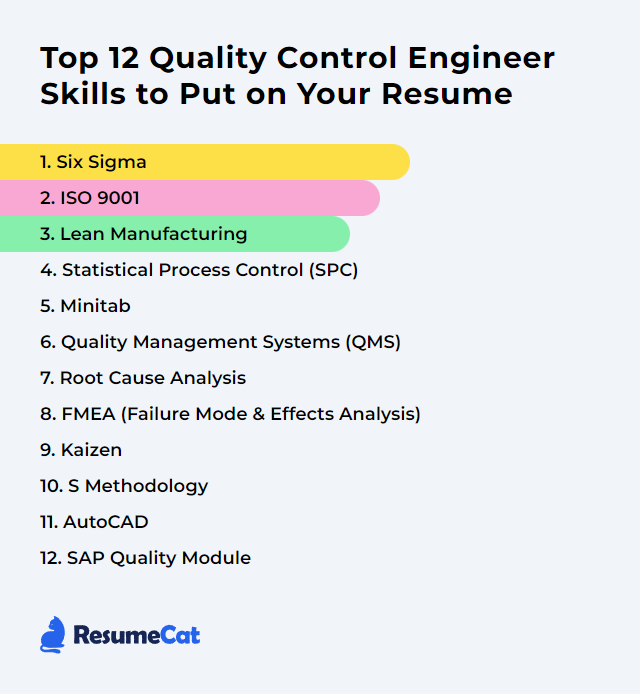Top 12 Quality Control Engineer Skills to Put on Your Resume
In the competitive field of quality control engineering, showcasing a blend of technical expertise and soft skills on your resume can significantly elevate your job candidacy. Here are the top 12 skills that demonstrate your proficiency in ensuring product excellence and operational efficiency, making you a standout applicant in this specialized area.
Quality Control Engineer Skills
- Six Sigma
- ISO 9001
- Lean Manufacturing
- Statistical Process Control (SPC)
- Minitab
- Quality Management Systems (QMS)
- Root Cause Analysis
- FMEA (Failure Mode and Effects Analysis)
- Kaizen
- 5S Methodology
- AutoCAD
- SAP Quality Module
1. Six Sigma
Six Sigma is a data-driven methodology for eliminating defects and driving down variation. It leans on statistics and disciplined problem solving to improve reliability, cost, and speed across processes.
Why It's Important
Six Sigma gives a Quality Control Engineer a rigorous roadmap (DMAIC: Define, Measure, Analyze, Improve, Control) to find root causes, reduce variability, and lock in sustainable gains that raise quality and customer satisfaction.
How to Improve Six Sigma Skills
Sharpening Six Sigma comes from practice, depth in analytics, and disciplined execution.
Elevate statistical fluency: Confidence with distributions, hypothesis tests, regression, DOE, and capability analysis makes projects faster and sturdier.
Pursue certification: Progress from Green Belt to Black Belt and beyond to deepen tools, leadership, and project ROI.
Apply DMAIC without shortcuts: Define tightly, measure with trustworthy data, analyze with evidence, improve iteratively, and control with robust plans.
Master core tools: FMEA, control charts, Pareto, fishbone, 5 Whys, and error-proofing. Use them often; keep templates lean.
Blend with Lean: Remove waste while reducing variation. Better flow plus tighter capability wins twice.
Keep learning: Case studies, communities of practice, and post-project reviews reveal blind spots and new moves.
Build a project portfolio: Real results, quantified. Cost saved, defects reduced, lead time cut—show your trail of impact.
How to Display Six Sigma Skills on Your Resume
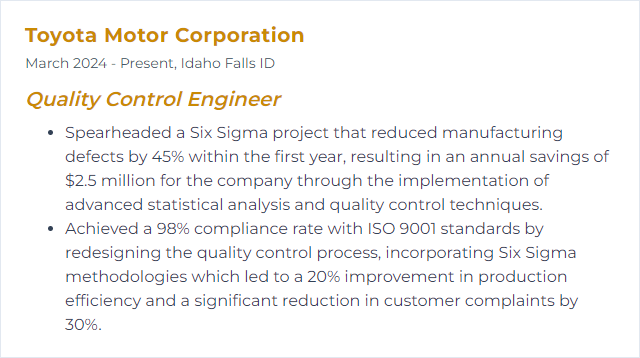
2. ISO 9001
ISO 9001 sets the requirements for a quality management system (QMS). It ensures consistent processes, compliance, risk-based thinking, and continual improvement—key pillars for dependable quality.
Why It's Important
For a Quality Control Engineer, ISO 9001 provides the framework to design, monitor, and improve processes that meet customer and regulatory requirements, consistently and audibly.
How to Improve ISO 9001 Skills
Strengthen the QMS by aligning it with strategy, data, and disciplined reviews.
Engage leadership (Clause 5): Connect quality objectives to business goals and make them visible.
Use risk-based thinking (Clause 6): Identify risks and opportunities early; link them to controls and KPIs.
Run PDCA relentlessly (Clause 10): Plan, execute, check, and refine. Small loops, frequent cadence.
Build competence (Clause 7.2): Define skills, train to gaps, verify effectiveness.
Listen to customers (Clause 9.1.2): Structure feedback, analyze trends, and act.
Audit smart (Clause 9.2): Risk-based audit plans, crisp findings, rapid containment, durable fixes.
Optimize processes (Clause 4.4): Map flows, remove waste, stabilize inputs, control outputs.
Tighten document control (Clause 7.5): Clear ownership, revision discipline, easy retrieval.
Manage suppliers (Clause 8.4): Qualified sources, performance scorecards, joint improvements.
Measure what matters (Clause 9): KPIs that reflect outcomes, not just activity. Review them in management meetings.
For depth, reference ISO 9001:2015 and your organization’s specific procedures and work instructions.
How to Display ISO 9001 Skills on Your Resume
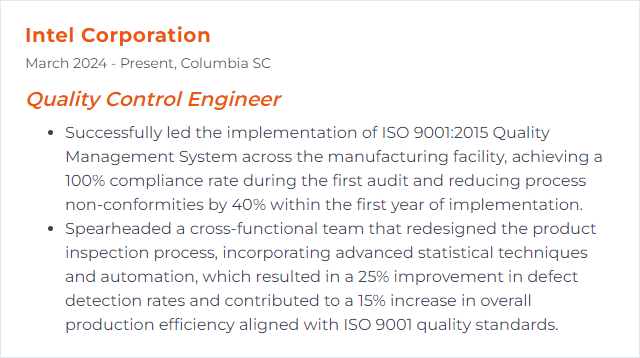
3. Lean Manufacturing
Lean Manufacturing targets waste—overproduction, waiting, transport, overprocessing, inventory, motion, defects—while protecting value. It’s about flow, pull, and respect for people.
Why It's Important
Quality Control Engineers thrive with Lean because stable, waste-free processes make defects rare, root causes clearer, and improvements faster to sustain.
How to Improve Lean Manufacturing Skills
Map the value stream: See end-to-end flow, expose bottlenecks and delays, then prioritize constraints.
Implement 5S: Sort, Set in order, Shine, Standardize, Sustain. Clutter gone, signals clear, errors drop.
Run Kaizen events: Short, focused, cross-functional sprints toward measurable gains.
Use poka‑yoke: Mistake-proof inputs and outputs to prevent defects rather than detect them.
Integrate Six Sigma: Pair flow improvements with variation reduction for durable capability jumps.
Anchor to the customer: Voice of customer drives specs, tolerances, and priorities.
Teach and standardize: Train teams, lock in wins with standard work, and audit lightly but often.
How to Display Lean Manufacturing Skills on Your Resume
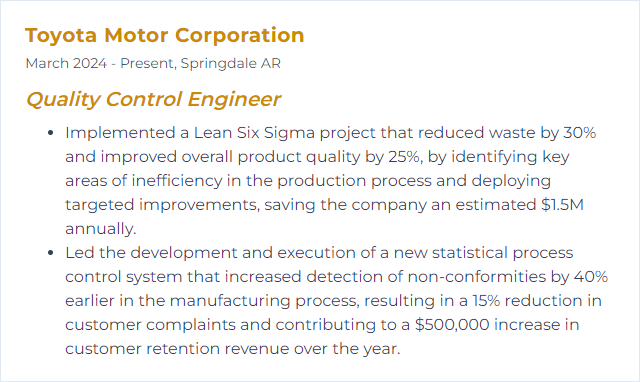
4. Statistical Process Control (SPC)
SPC uses statistical methods and control charts to monitor stability, detect special-cause variation, and keep processes capable over time.
Why It's Important
It turns data into early warning signals. A Quality Control Engineer can act before defects spread, cut scrap, and protect customer trust.
How to Improve Statistical Process Control (SPC) Skills
Train the team: Everyone touching the process should grasp common vs. special cause, chart interpretation, and reactions.
Pick the right chart: X‑bar/R, X‑bar/S, I‑MR, p, np, c, u—match chart to data type and subgrouping.
Establish baselines: Use clean historical data to set control limits and assess capability (Cp, Cpk, Pp, Ppk).
Monitor in real time: Digital data collection, automated updates, clear rules (e.g., Western Electric) for out-of-control signals.
Close the loop: When signals appear, contain, find root cause, standardize the fix, and verify restored control.
Expand upstream and to suppliers: Apply SPC to critical incoming characteristics and key sub-processes.
Review and refine: Periodically reassess sampling, subgrouping, and metrics as the process matures.
How to Display Statistical Process Control (SPC) Skills on Your Resume
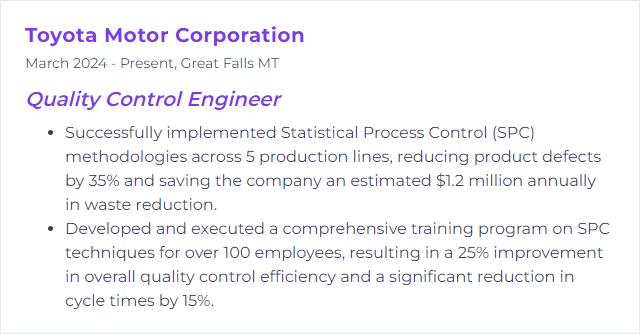
5. Minitab
Minitab is statistical software built for quality improvement—control charts, capability, DOE, regression, and more—fast to learn, powerful in practice.
Why It's Important
It accelerates analysis and visualization, helping a Quality Control Engineer diagnose quickly, prove impact, and communicate results with clarity.
How to Improve Minitab Skills
Nail the fundamentals: Navigation, worksheets, graphs, session output, and proper data structuring.
Go deep on QC tools: Attribute and variable charts, capability studies, gage R&R, and process mapping.
Practice with real data: Use shop-floor datasets, run pilot analyses, and compare before/after performance.
Use macros and automation: Standardize repetitive analyses to reduce error and save time.
Stay current: Explore new features periodically; update workflows when they reduce friction.
Peer review: Have another engineer review assumptions and outputs to avoid analytical traps.
How to Display Minitab Skills on Your Resume
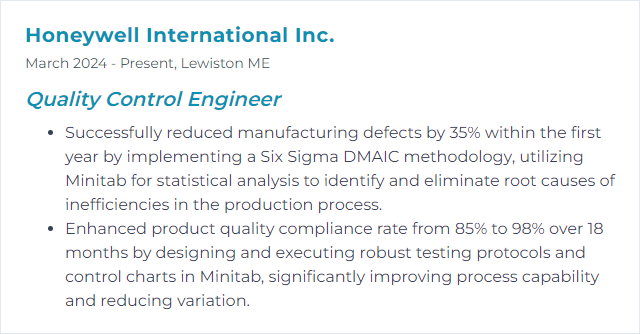
6. Quality Management Systems (QMS)
A QMS documents policies, processes, and procedures to meet quality objectives. It aligns people and technology to deliver compliance, consistency, and constant improvement.
Why It's Important
For a Quality Control Engineer, a strong QMS creates predictable outputs, faster problem resolution, and a backbone for audits and certification.
How to Improve Quality Management Systems (QMS) Skills
Assess current state: Internal audits, process metrics, and voice-of-customer reveal where to focus.
Engage stakeholders: Involve operators, engineers, suppliers, and customers to design practical controls.
Train continuously: Role-based training with refreshers; verify effectiveness, not just attendance.
Digitize wisely: Document control, nonconformances, CAPA, and audit workflows in a centralized system.
Set SMART objectives: Clear targets for defects, on-time delivery, audit findings, and customer complaints.
Use root cause methods: 5 Whys, fishbone, fault tree—fix causes, not symptoms.
Promote continuous improvement: Lean, Kaizen, and Six Sigma projects tied to business outcomes.
Review performance: Management reviews that challenge results, unblock resources, and recalibrate plans.
How to Display Quality Management Systems (QMS) Skills on Your Resume
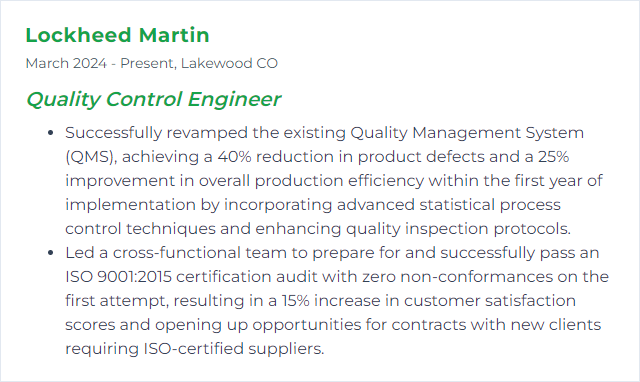
7. Root Cause Analysis
Root Cause Analysis (RCA) is a structured approach to uncover why a defect or deviation occurred, so the fix prevents recurrence—not just this time, but next time too.
Why It's Important
It turns scattered symptoms into a clear mechanism. With RCA, corrective actions target the real levers, improving quality and reliability for good.
How to Improve Root Cause Analysis Skills
Build cross-functional teams: Quality, design, manufacturing, maintenance, and suppliers—multiple lenses cut bias.
Collect complete data: Time-stamped histories, process settings, environmental factors, operator notes, and photos.
Use structured tools: 5 Whys, fishbone diagrams, fault tree analysis, and Pareto charts.
Leverage visualization: Trend charts, heat maps, and layering by lot, line, or shift to expose patterns.
Train critical thinking: Challenge assumptions, test hypotheses, and seek disconfirming evidence.
Capture lessons learned: A searchable knowledge base prevents déjà vu failures and speeds future fixes.
Verify effectiveness: After action, monitor metrics long enough to ensure the problem stays gone.
How to Display Root Cause Analysis Skills on Your Resume
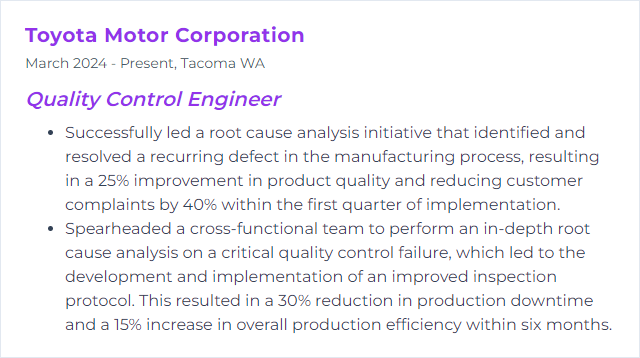
8. FMEA (Failure Mode and Effects Analysis)
FMEA is a proactive, step-by-step method to identify potential failure modes, assess their effects and causes, and prioritize preventive actions before issues hit customers.
Why It's Important
It reduces risk, boosts reliability, and lowers cost by designing out problems early or controlling them tightly in the process.
How to Improve FMEA (Failure Mode and Effects Analysis) Skills
Form a cross-functional team: Design, manufacturing, quality, service—complementary expertise surfaces hidden risks.
Train on the latest approach: Align with AIAG-VDA FMEA methods, including Action Priority (AP) over legacy RPN scoring.
Use historical evidence: Field returns, warranty data, scrap/rework trends, and past FMEAs inform likely failure modes.
Be precise and measurable: Clear functions, failure effects, causes, and current controls—no vague wording.
Prioritize actions: Target high-severity and poor-detection risks first; assign owners and due dates.
Treat as a living document: Update after design changes, process shifts, or new learnings.
Link to control plans and SPC: Ensure controls are verified, monitored, and audited.
How to Display FMEA (Failure Mode and Effects Analysis) Skills on Your Resume
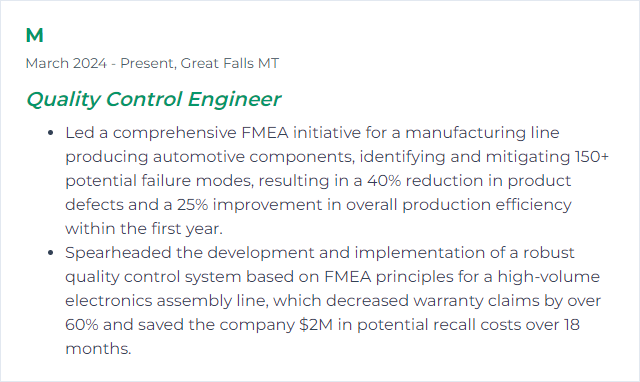
9. Kaizen
Kaizen means continuous improvement—small, steady changes that compound into big gains in quality, efficiency, safety, and morale.
Why It's Important
It embeds improvement into daily work. Problems surface faster, solutions come from the people closest to the process, and quality keeps inching up.
How to Improve Kaizen Skills
Spot the friction: Walk the gemba, observe, and record obstacles as they happen.
Set sharp goals: Specific, measurable, time-bound targets clarify what success looks like.
Engage everyone: Team huddles, idea funnels, and quick experiments encourage contributions.
Start small: Low-cost, low-risk changes build momentum and proof.
Measure, then adjust: Compare before and after with simple, visible metrics.
Standardize the wins: Update work instructions and training so improvements stick.
Repeat: Improvement cycles never stop—schedule them.
How to Display Kaizen Skills on Your Resume
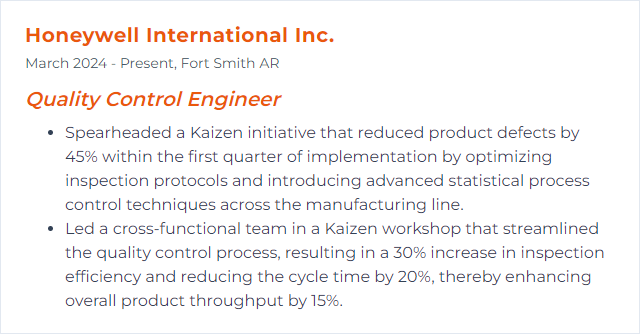
10. 5S Methodology
5S is a workplace organization system—Sort, Set in order, Shine, Standardize, Sustain—that reduces errors, speeds work, and makes abnormalities pop out.
Why It's Important
For a Quality Control Engineer, 5S creates a controlled environment where deviations are visible, measurement is easier, and defect opportunities plummet.
How to Improve 5S Methodology Skills
Audit routinely: Visual checklists, scored audits, and photos to track progress.
Use visual management: Labels, color coding, shadow boards, and floor markings to guide behavior.
Standardize best practice: Clear ownership, standard work, and simple training.
Eliminate clutter ruthlessly: Red-tag events to remove what’s not needed.
Make it a habit: Daily 5-minute sustain activities beat quarterly cleanups.
How to Display 5S Methodology Skills on Your Resume
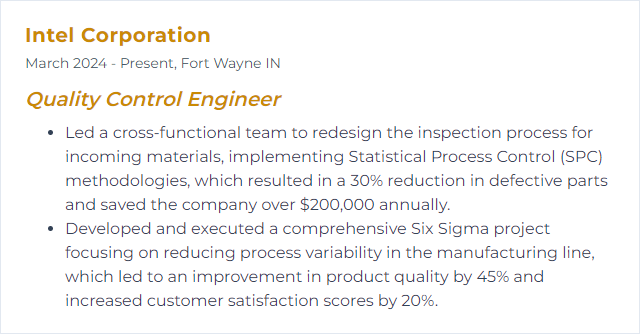
11. AutoCAD
AutoCAD enables precise 2D/3D drafting and model reviews. Quality Control Engineers use it to verify tolerances, check GD&T, and communicate changes unambiguously.
Why It's Important
Accurate drawings and redlines prevent costly interpretation errors, ensuring the product built matches the product intended.
How to Improve AutoCAD Skills
Lean on precision tools: Object snaps, tracking, constraints, and inquiry commands for exact geometry.
Standardize templates: Layers, title blocks, linetypes, and plotting standards for consistent, audit-ready drawings.
Automate repetitive work: Blocks, dynamic blocks, scripts, and action recorder to reduce variation and time.
Stay updated: New features often simplify markup, collaboration, and QA checks.
Targeted training: Focus on GD&T, sheet sets, Xrefs, and collaboration workflows relevant to quality reviews.
How to Display AutoCAD Skills on Your Resume
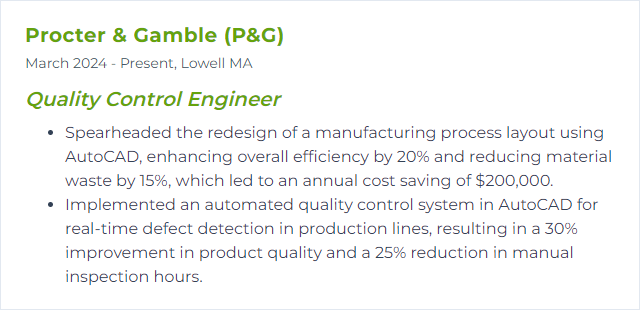
12. SAP Quality Module
The SAP Quality Management (QM) module manages inspections, nonconformances, notifications, and quality planning across the value chain. In ECC and S/4HANA, it ties quality to materials, production, procurement, and sales.
Why It's Important
It centralizes quality data, automates workflows, and integrates with upstream and downstream processes, enabling faster containment and cleaner compliance.
How to Improve SAP Quality Module Skills
Integrate with core modules: MM, PP, SD, and EWM for end-to-end traceability and timely quality triggers.
Tailor inspection plans: Characteristics, sampling procedures, and acceptance criteria aligned to specs and regulations.
Use analytics: Dashboards and KPIs to surface trends, predict risks, and prioritize actions.
Automate the routine: Notifications, approvals, and report generation via workflows and SAP Build Process Automation.
Train users and super users: Role-based training, quick reference guides, and office hours to stabilize adoption.
Close the feedback loop: Gather input from inspectors, planners, and auditors; refine master data and processes continuously.
How to Display SAP Quality Module Skills on Your Resume

